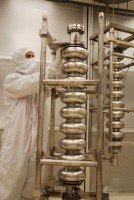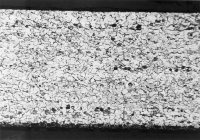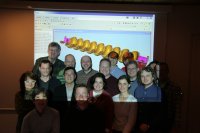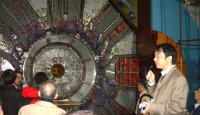US-manufactured cavity achieves high gradient

Damon Bice, a Fermilab technician studying at JLab for the year, disassembles the AES2 cavity from the test stand for another round of electropolishing and vertical tests. (Image courtesy of JLab) |
Turkey, stuffing and pumpkin pie – all things you might appreciate on Thanksgiving. ILC scientists in the United States had something extra to be thankful for this year. On 21 November, the day before the Thanksgiving holiday in the US, a superconducting cavity manufactured by Advanced Energy Systems in Medford, NY, reached a high gradient of 32.6 megavolts per metre (MV/m) at Jefferson Laboratory. “This is the first US-built ILC nine-cell cavity to reach a gradient close to the ILC specification,” said Rongli Geng, the lead scientist at JLab on the nine-cell high-gradient cavity processing R&D. JLab scientists are hopeful that the cavity, dubbed AES2, will reach an even higher gradient after further processing.
Read more...
-- Elizabeth Clements |
|
 |
ILC challenges materials science

Cut of niobium sheet: Only well recrystallised niobium can successfully be formed to a cavity shape. (Photo: CEA) |
Physicists and engineers already know most of the empirical recipes to build very good accelerating cavities: highly pure niobium is essential, welding needs to be carefully controlled and surfaces undergo advanced cleaning and annealing procedures. But, as for every complex system, a lot of phenomena remain unexplained. The theoretical limits of RF superconductivity are not well known, and engineers also meet practical limitations to reach high gradients. Accelerator experts work very closely with material scientists to understand cavity properties better.
Read more...
-- Perrine Royole-Degieux |
 |
|
|
 |
In the picture

No dumbbells or weight bars were involved when 17 participants met at DESY last week for the very first ‘power training’ for the Engineering Data Management System. The participants, coming from all three ILC regions, learned all about the online system that lets you handle Computer-Aided Design (CAD) applications, track versions, design, edit, link, tag and publish. Experts on CAD worked with experts on electronic data handling, learning about what the others need and what they have on offer. They are now trainers for their regions and can organise their own power training sessions.
|
 |
|
|
 |
From nature physics 3, 823
December 2007
Closed circle
CERN's latest accelerator is taking shape
Read more... |
|
From Daily News and Analysis India
28 November 2007
Industry should benefit from tie ups in int'l projects
MUMBAI: Indian industry should take advantange of the country's involvement in prestigious international projects like ITER and work with top scientific institutions to meet the huge demand for ultra vacuum systems, S Banerjee, Director of Bhabha Atomic Research Centre said here on Wednesday.
Read more... |
|
|
 |
 |
|
|
 |
China prepares for a new generation of tau-charm physics

Wang Yifang, Associate Director and Director of the Center for Experimental Physics of IHEP, dedicating the inserted drift chamber (on the left). |
The BEPC accelerator and BES detector facility are the centerpieces of the Institute of High Energy Physics in Beijing. These ambitious state-of-the-art facilities act as the follow-on to the pioneering studies at SPEAR of tau and charm physics. During the International Linear Collider CCAST workshop at IHEP last month, we had a tour of the accelerator facility and by fortuitous timing, we joined in their celebration of achieving a major milestone for the BES detector: the successful installation of the central drift chamber. The upgraded accelerator and detector at IHEP promise to produce important tau-charm physics, as well as to train a new generation of particle and accelerator physicists. The development of particle physics over the past decade at IHEP and its participation in the global particle physics programme put China in a position to be an important player in the next generation of particle physics experiments, including Daya Bay neutrinos, the Large Hadron Collider and the ILC.
Read more...
-- Barry Barish
Director's Corner Archive |
 |
|
|
 |
What is it?

These colourful lines we asked you to identify last week are of course RF signals on a cavity. Congratulations to Stuart Henderson (Oak Ridge National Lab), Matthias Felber and Alexander Gamp (both DESY) who all got it right! Read the full explanation from KEK here.
Read more...
Register for TILC08
Registration is now open for the next collaboration-wide meeting. The joint GDE and ACFA Physics and Detector Workshop will be held in Sendai, Japan, from 3 to 6 March 2008.
More information
ILC Notes
2007-033
Readout Inefficiency due to Finite Buffering
2007-032
Leak rate measurements on bimetallic transition samples for ILC cryomodules
2007-031
Leak rate measurements on bimetallic transition samples for ILC cryomodules
2007-030
Radiolysis in the ILC Main Beam Dumps
arXiv preprints
0711.49
The charged Higgs boson mass in the 2HDM: decoupling and CP violation
0711.482
Seesaw at Collider, Lepton Asymmetry and Singlet Scalar Dark Matter
0711.4754
Disentangling the Unparticles with polarized beams at e+e- colliders
0711.436
Two Higgs Models for Large Tan Beta and Heavy Second Higgs
|
|

